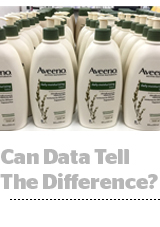 Data and analytics are breaking down the walls between Johnson & Johnson’s shopper marketing and national marketing plans.
Data and analytics are breaking down the walls between Johnson & Johnson’s shopper marketing and national marketing plans.
Danielle Price manages shopper marketing and consumer promotions for J&J’s Aveeno brand after working as a J&J shopper marketing rep to Walmart. Her new job spans shopper marketing and national promotions, which used to be two roles, but analytics now helps bridge the worlds of shopper marketers, who must move inventory off specific retail shelves, with national marketers, who are concerned about media and audiences.
“At Walmart I had every number you could ever need, and I came to this role and realized shopper marketers weren’t getting the metrics they need,” Price said.
It’s easy to measure coupons and deals promoted in a grocery store aisle because they’re redeemed at a cash register, but they don’t connect to media metrics or the brand’s audience.
Are coupons bringing new customers to the brand or just teaching loyalists to load up on deals? Do customers buy across the Aveeno portfolio of skin, hair and beauty products or is their interest product-specific?
Those are the kinds of questions shopper marketers haven’t been able to answer but are figuring out by incorporating more data-driven channels into their marketing mix, Price said.
Aveeno products are sold almost entirely in stores – its website doesn’t even support direct ecommerce – but investing more online helps to better understand its brick-and-mortar customers, Price said.
For instance, Aveeno has worked with the ecommerce marketing company Quotient to distribute deals on its coupons.com property, but in the past year it began testing Quotient’s media buying and analytics to connect coupon redeemers to online audiences.
Nearly half of those who clicked on the Quotient promotion campaign redeemed multiple offers. That’s a big step for Aveeno, because the brand estimates only 10% of customers currently buy multiple products in its portfolio, Price said.
Aveeno validated the campaigns with Quotient in part by measuring household penetration with Nielsen and running lift tests with retail data company Catalina, Price said. But Quotient also brings an important new stream of data, since Catalina, IRI and other store transaction data companies exclude top retail chains that have proprietary data platforms, such as Walmart and Target.
Quotient’s supply sources include retail networks it powers directly, including Albertsons and Dollar General, and retailers with first-party ad platforms, such as Walmart, Target and CVS.
Coupon redemptions represent the majority of Quotient’s business, but COO Chad Summe said media sales “are on a trajectory to take it over.”
In its most recent earnings report as a publicly traded company, Quotient’s coupon promotion and online advertising businesses earned $63.3 million and $40.3 million, respectively. But the media revenue is growing nearly 70% year over year, compared to 17% growth for its coupons.
“Much of what we’re doing with CPGs is trying to break down the silos that have historically defined how they operate in either promotions, media or data,” Summe said. “What we see is a convergence toward conversion-based marketing.”
This post was syndicated from Ad Exchanger.


More Stories
Scroll Media boosts in-game advertising with new feature
Kiwi filmmaker spotlights media struggles at top global awards
T-Mobile Has Appointed Kristin Harrer As Senior Vice President and Chief Brand Officer